
 HMS VERSATILE
HMS VERSATILE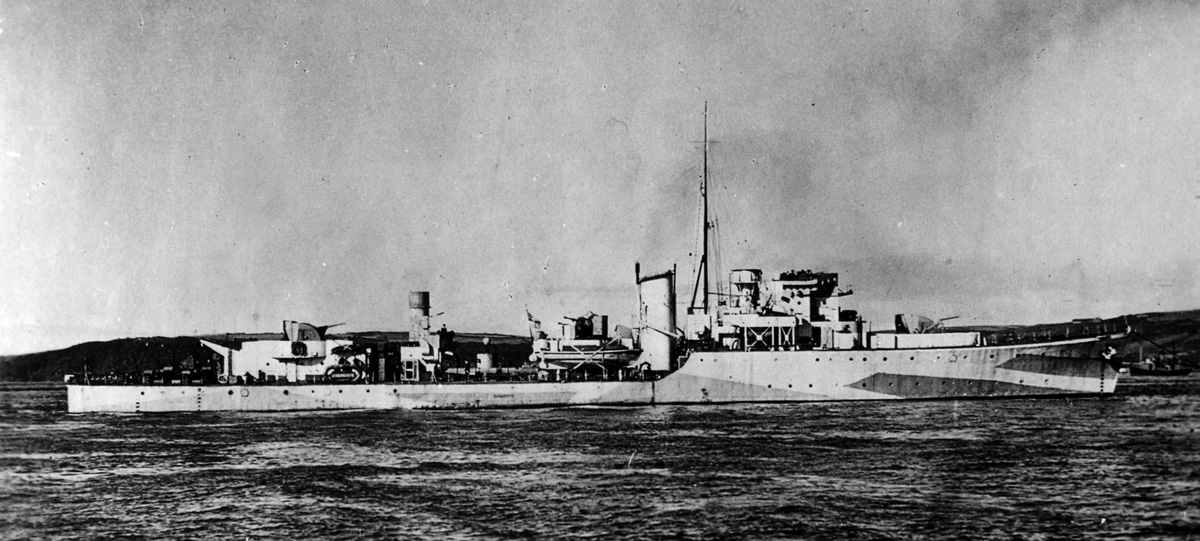
Click on the links within this brief outline for first hand accounts by
the men who served on HMS Versatile and for a more detailed chronology see www.naval-history.net
HMS Versatile was
the first Royal Navy ship of the name. She was laid down on 31 January
1917 by Hawthorn Leslie and Company at Tyneside, launched on 31 October
1917, completed on 11 February 1918 and commissioned into service
the same day. She was one of several V & Ws fitted with mine rails
on either side of the hull. During 1919, Versatile
took part in the British campaign against Bolshevik forces in the
Baltic Sea during the Russian Civil War. She then served in the 1st
Destroyer Flotilla in the Atlantic Fleet.
On 23 March 1922, Versatile
was steaming off Europa Point, Gibraltar, at 20 knots with other
destroyers while British submarines practiced attacks on them. The
submarine H42 surfaced unexpectedly ahead of her. Versatile
went full speed astern and put her helm over hard to port, but
rammed H42 abaft the conning tower, almost slicing the submarine in
half. H42 sank with the loss of all hands. An investigation found H42
at fault for surfacing where she did against instructions. In 1931, Versatile was engaged in minelaying in the Heligoland Bight off the mouth of the Elbe as shown in the photographs taken by Lt Colin G.W. Donald RN.
Later that year she joined her flotilla in a three-week cruise to ports
on the Baltic Sea. In October 1936 she was decommissioned and placed in
reserve at the Nore.
The Royal Navy recommissioned Versatile
in 1939 and she was deployed with the 11th Destroyer Flotilla for
convoy defence duty in the Southwestern Approaches based at Plymouth.
In May 1940 – the month in which her pennant number was changed from D32 to I32
– Versatile was detached from
convoy duty and assigned to operations related to the evacuation of
Allied personnel from the Netherlands, Belgium, and France. On 12 May
1940 she ran aground on the Dutch coast but was towed off by the
destroyer Walpole. Early on 13 May 1940, Versatile took part in Operation Ordnance, the evacuation of Allied personnel from the Hook of Holland, with HMS Malcolm, Windsor and Vivien. That evening, she was escorting the destroyer Hereward,
upon which Queen Wilhelmina of the Netherlands was embarked for passage
to Breskens, when German aircraft attacked at 20:45 hours. One bomb
struck Versatile's upper
deck, flooding her engine room, killing nine men, wounding a third of her crew and leaving her dead in the water. This is described by the grand daughter of an anonymous stoker who served in HMS Versatile from 11 April 1940 to 29 September 1942. The
destroyer HMS Janus (F53) towed her to Sheerness, England, for repairs.
After completing repairs in June 1940, Versatile
was assigned to the 21st Destroyer Flotilla at Sheerness and began
convoy duty in the English Channel and Southwestern Approaches. On 27
June 1940, about 150 nautical miles west of Ushant, France, she
rescued 13 of the 40 survivors of the Royal Navy special service vessel HMS Cape Howe, operating under the cover name RFA
Prunella to conceal its identity as a submarine decoy vessel or "Q-ship", which the German submarine U-28 sunk on 21 June 1940 with the loss of 56 lives.
On 25 August 1940, Versatile and Vimy were transferred to the Home Fleet at Scapa Flow in the Orkney Islands and operated in Scottish waters and north to Iceland until oil leaks and problems with her Asdic and degaussing coil in October required repairs and a refit on the Tyne. She then joined the Rosyth Escort Force protecting east coast convoys from attack by e-boats and bombers in 1941-2. Versatile was "adopted" by Tipton in Staffordshire in a Warship Week fundraising campaign in February 1942.
In
January 1943 she was converted to a Long Range Escort (LRE) at
Grangemouth which increased her range by removing one boiler making
more room for fuel but reducing her speed; she was also fitted with the
Hedgehog AS weapon. In November 1943 she joined the B7 Escort Group
escorting Atlantic Convoys. In November while escorting Convoy ONS.23
she ran into such heavy seas and shipped so much water she was forced
to return to her base at Londonderry. This may have been the occasion graphically described 46 years later by Lt D. Langston-Jones RNVR. Arthur Robinson, an ERA in the Engine Room, gives a frank if indiscrete account of events in Hard Lying,
She was under repair at Milford Haven and Belast from February to early April when preparations were in hand for Operation Neptune, the invasion of Normandy. Newer frigates and corvettes took over the Atlantic long range escort duties and Versatile and the older escorts were relegated to escort duties in the English Channel. On D Day, 6 June 1944, she was escorting components of the Mulberry Artificial Harbours being towed from England and Rear Admiral W.G. Tennant RN embarked on Versatile to inspect the towing of the components.
Once the allied armies were ashore Versatile
and the other escorts were based at Portsmouth and Plymouth escorting
shipping to the beaches before joining the Nore Command at Chatham
escorting shipping to Ostend and Antwerp until the end of the war. An
insight into life on Versatile during this period is given below by Sub Lt Alan Marsh RNVR.
By the 26 May 1945 Versatile
was in the Humber reduced to Reserve and by the 8 June at Rosyth where
she remained until May 1947 when she was handed over to the British
Iron and Steel Corporation (BISCO) and on 6 August was sent to M.
Brechin at Granton, Scotland, for scrapping.
The naval historian Robert Ruegg (1933 - 2012) wrote a six page account of the wartime service of HMS Versatile which can be seen as a PDF by clicking on the link.
Commanding Officers
| Cdr Gerald C. Wynter, RN (19 January, 1918 - November, 1920) Cdr Evelyn H. B. L. Scrivener, 19 May, 1920 – 14 June, 1920 (temporary) Cdr Victor L.A. Campbell RN (Sept 1920 - Dec 1922) Cdr Lawrence D'O. Bignell, R (14 September, 1922 – 21 May, 1923) Cdr John Fawcett, RN (April, 1923 – 7 Feb. 1926) Cdr Alexander L. Fletcher, RN (9 Feb 1926 – 1 April, 1926) Lt Cdr Martin J. C. de Meric, RN (1 May, 1926 – 31 March, 1927) Cdr Colin S. Thomson, RN (31 March, 1927 – March, 1929) Lt Cdr Walter N. T. Beckett, RN (March, 1929 – 25 June, 1929) Cdr Edmund G. N. Rushbrooke, 25 June, 1929 – November, 1930 Capt John F. B. Carslake, RN (8 November, 1930 |
Capt Claude P. Hermon-Hodge, RN (4 August, 1931 – 10 August, 1932) Cdr Rhoderick R. McGrigor, RN (10 August, 1932 - Cdr Cecil B. Turner, RN (January, 1934 -
Lieutenant (in Command?) Francis A. L. H. Watson, RN (1 August, 1935 -
Cdr. (retired) Thomas Andrew Hussey, RN (15 June 1939 - June 1940)Cdr. (retired) John Henry Jauncey, RN (June 1940 - 29 Apr 1941) Lt.Cdr. Jack Barrington Palmer, RN (29 April 1941 - Nov 1942) Lt. Denis Guy Douglas Hall-Wright, RN (Nov 1942 - early 1943) Lt.Cdr. Geoffrey Stuart Corlett, DSC, RN (1 Sep - Dec 1943) Lt. Gilbert Charles Potter, DSC, RN (Dec 1943 - 3 Oct 1944) Lt. Alfred Lee Harper, RN (3 Oct 1944 - mid 1945) |
Sub Lt Alan Spencer Marsh RNVR
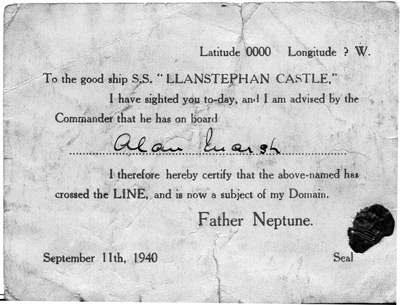
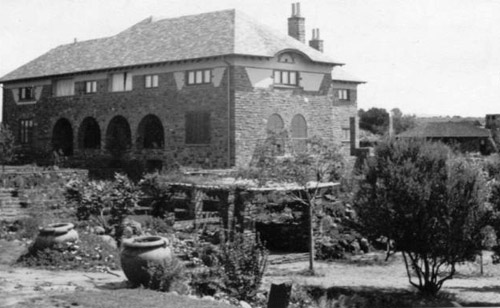 Alan was born in 1925 at Iver
in Buckinghamshire, the younger of the two children of Spencer and May
Marsh. His father was a retired army Major who had served
during the First World War and in India, before becoming a schoolteacher.
The family moved to Chelmsford where Alan spent most of his childhood
and attended the King Edward VI Grammar School. In June 1940 he
collected some shrapnel from a local field, a fragment of a shot-down
Heinkel.
Alan was born in 1925 at Iver
in Buckinghamshire, the younger of the two children of Spencer and May
Marsh. His father was a retired army Major who had served
during the First World War and in India, before becoming a schoolteacher.
The family moved to Chelmsford where Alan spent most of his childhood
and attended the King Edward VI Grammar School. In June 1940 he
collected some shrapnel from a local field, a fragment of a shot-down
Heinkel.
Alan Marsh was one of 308 children evacuated to South Africa, traveling from Liverpool to Cape Town on RMS Llanstephan Castle, under the Children's Overseas Reception Board (CORB) programme, on 24 August 1940. The programme was ended less than a month later when the evacuation ship SS City of Benares
carrying 90 children bound for homes in Canada, was torpedoed and sunk
on 17 September 1940.
Alan and his friend Johnny Beswetherick were
billeted with the Champion family at "The Ridge" (on right) in
Bloemfontein and educated at St Andrew’s School. Johnny was a
year younger than Alan but got them into trouble by organising a party
while the Champions were away which led to them being sent to St Andrew's
as boarders instead of day boys.
Elaine Marsh recalled that:
*******************
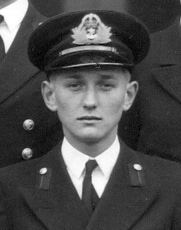
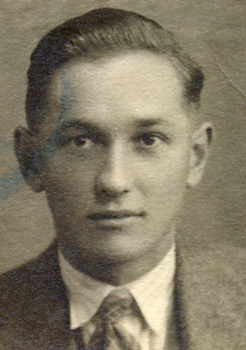 He volunteered for the Royal Navy on 6 September. Having matriculated
(and being the son of a retired Army officer) he was selected for
officer training under the 'Y' scheme which recruited
educationally qualified young men while still at school. He did his
basic new entrant training as a naval rating at Raleigh and on HMS Diomede, a Danae Class Light Cruiser which had been newly converted into a training ship at Rosyth. He then did his officer training at HMS King Alfred,
the Royal Naval Volunteer Reserve (RNVR) Officer training establishment
at Hove, East Sussex. He was sent to the Royal Naval College at
Greenwich on a two week training course before joining HMS Versatile at Londonderry as a Midshipman on 20 July 1944.
He volunteered for the Royal Navy on 6 September. Having matriculated
(and being the son of a retired Army officer) he was selected for
officer training under the 'Y' scheme which recruited
educationally qualified young men while still at school. He did his
basic new entrant training as a naval rating at Raleigh and on HMS Diomede, a Danae Class Light Cruiser which had been newly converted into a training ship at Rosyth. He then did his officer training at HMS King Alfred,
the Royal Naval Volunteer Reserve (RNVR) Officer training establishment
at Hove, East Sussex. He was sent to the Royal Naval College at
Greenwich on a two week training course before joining HMS Versatile at Londonderry as a Midshipman on 20 July 1944. Alan Marsh served in HMS Versatile
as a Midshipman and Sub Lieutenant from July 1944 until she was decommissioned in 1946. Although he
was a member of the V & W Destroyer Association he did not write
anything for publication in the Association's magazine, Hard Lying,
and I am indebted to his widow Elaine Marsh for the scans of
photographs from his album and the few random memories of his wartime
service in Versatile.
The photograph on the left was cropped out from a photograph of the
young officers attending the course at Greenwich in June 1944 and the
one on the right was taken in 1948 after he left the Navy. When Versatile was
sent for scrapping he took possession of the Ship's Log for the last quarter and the
wooden name plate with the ship's name spelled out in brass letters wich was sadly lost. In
later life he corresponded with one of his fellow officers whose frank comments bring this account of his time in Versatile to life.
Versatile had been converted into a Long Range Escort (LRE) and she met some of the East bound Atlantic Convoys from New York City to Liverpool (HX.308, HX.314, HX.348 and HX.351). Alan Marsh joined Versatile after the success of the D-Day landings on the Normandy beaches when the u-boats abandoned their bases on the Atlantic coast of France and the Atlantic convoys reversed their direction. Instead of rounding the north of Scotland and meeting the Rosyth Escort Force at Methil on the Firth of Forth for the journey south down the east coast to the Thames estuary they took the direct route through the English Channel. HMS Versatile left her base in Londonderry and moved to Chatham on the Medway and became one of the escorts for the convoys in the Western Approaches and the Channel.
Versatile was known affectionately by her officers and men as 'Tilly' and the ship's dog was given the same name. Vanquisher, usually Versatile’s partner on convoys along the south coast, was known as ‘Squisher’.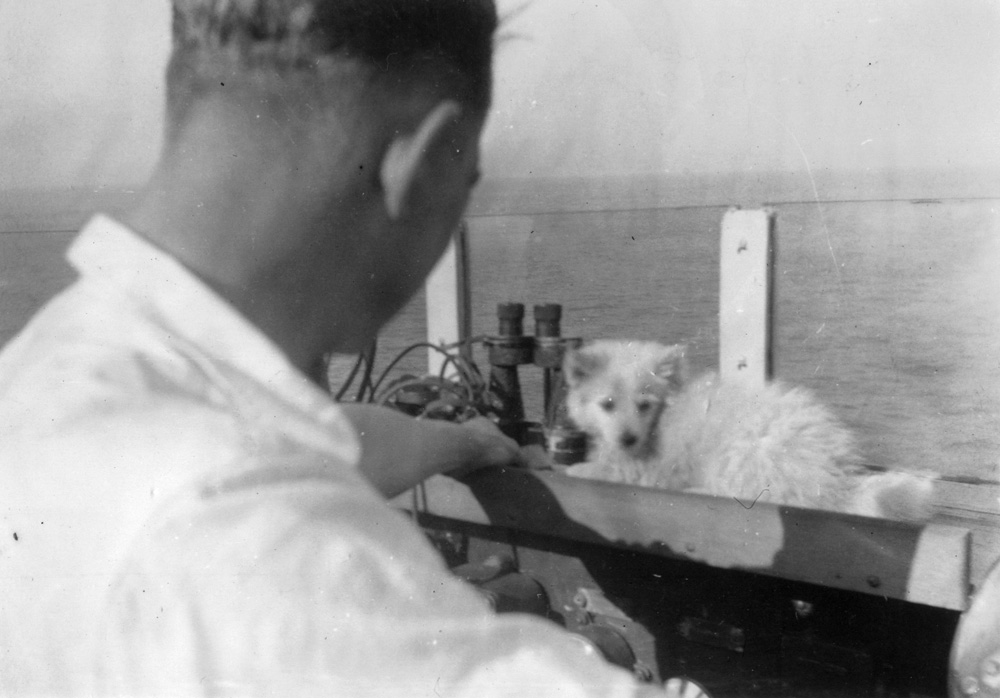
The Ship's dog "Tilly" and"Guns", Gunner (T), Warrant Officer G W Butler RN, share a Watch on the open bridge of HMS Versatile on a fine day
Tilly was named after Versatile which was affectionately known by those who served in her as "Tilly"
Courtesy of Elaine Marsh
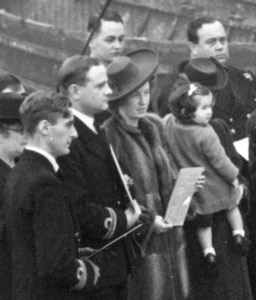 From left: NK, Lt A. Harper - the father, NK, Salter?
|
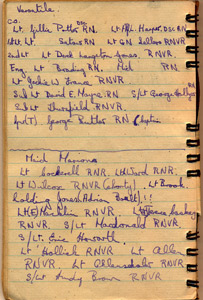 |
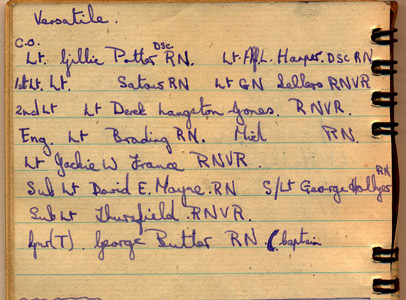 |
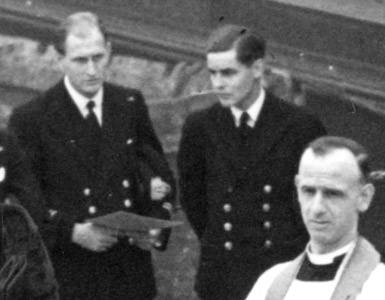 From left: Derek Langston-Jones & David Mayne
|
Alan Marsh wrote the names of the officers he served with in a notebook and got back in touch with one of them in 1990 after an absence of 46 years and in their letters they reminisced about their time together in Versatile, including some frank exchanges about senior officers which are revealing about attitudes in the Navy as well as personal prejudices. 2nd Lt Derek Langston-Jones RNVR recalled an incident on an Atlantic convoy which might have led to the loss of the ship:
Baptism of Berenice Lee Harper, the daughter of the CO,
Lt. Alfred Lee Harper, RN at Chatham in October 1944
Double click the image to view full size for close up of the family and officers
Courtesy of Elaine Marsh
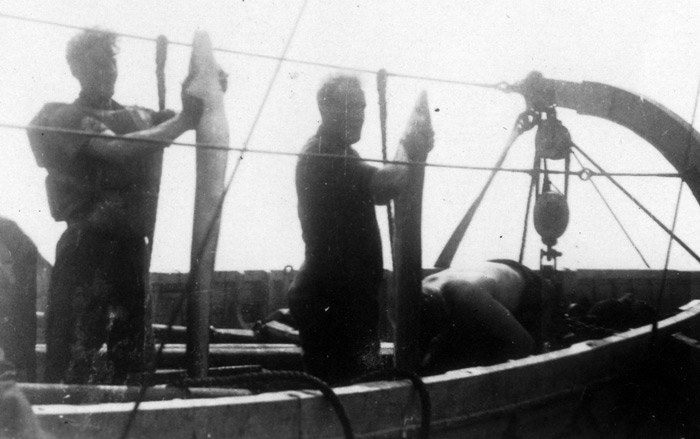
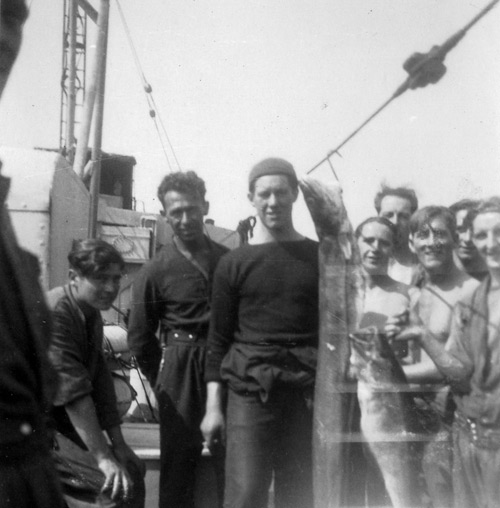
Versatile depth charged a shoal of fish identified by the Asdic as a U-Boat near Beachy Head and the ship's company enjoyed fresh fish for dinner
Courtesy of Elaine Marsh
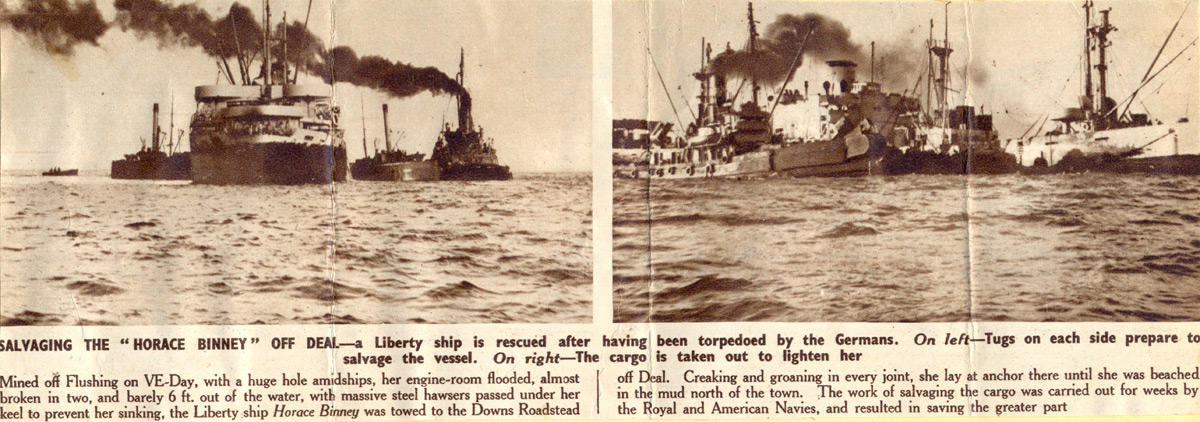
HMS Versatile was on hand to assist in the beaching and salvage of the Horace Binney
Deal is on the East coast of Kent just south of the North Foreland
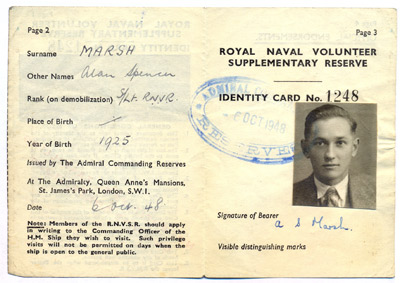
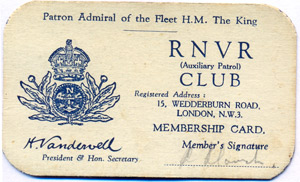
Alan Marsh remained in the Navy after the war ended on the day he saw the Horace J Binney mined but left HMS Versatile soon afterwards. He was posted to HMS Mayina, a shore base in Ceylon and from there to HMS Maid Marion,
an armed yacht requisitioned by the Admiralty in 1939 and being used as
a tender to the submarine flotilla based at Trincomalee. In March 1946
he left Maid Marion and joined HMS Bushwood,
a deperming ship based at Trincomalee. This was his last sea going
appointment before leaving the Navy in March 1947. He was a member of
the Royal Navy Volunteer Supplementary Reserve until August 1948 and a
member of the RNVR Club (now known as the Naval Club).
He was still a sub lieutenant but only 22 years of age and young enough to start a new life.He
took a degree in
Chemistry at London University where he met his future wife, Trudy.
Trudy's full name was Gertrude Hilton Hackles. She
came from Falmouth in Cornwall and they married in 1950. Alan
became
an industrial chemist and worked for
Courage’s Brewery for the rest of his life, retiring as their Chief
Chemist. He lived at various addresses in and around Farnham and
Guildford in Surrey for most of his working life, his last house before
retirement was at Wrecclesham, near Farnham. His last working base was
Courage's Reading Brewery although he had to visit breweries all over
the country and abroad. Alan and Trudy had two daughters , Patricia and
Jane,
and four
grandchildren.
He moved to Budleigh Salterton a small seaside town near Exmouth on the south coast of
Devon when he retired in 1987. His first wife died in 2000 and he met
Elaine Norsworthy through the Croquet Club, one of the biggest in the country, who "introduced Alan to new
experiences and adventures, returning to South Africa, winning croquet
competitions, eating garlic" which led to their marriage in
2008. He died in December 2013.
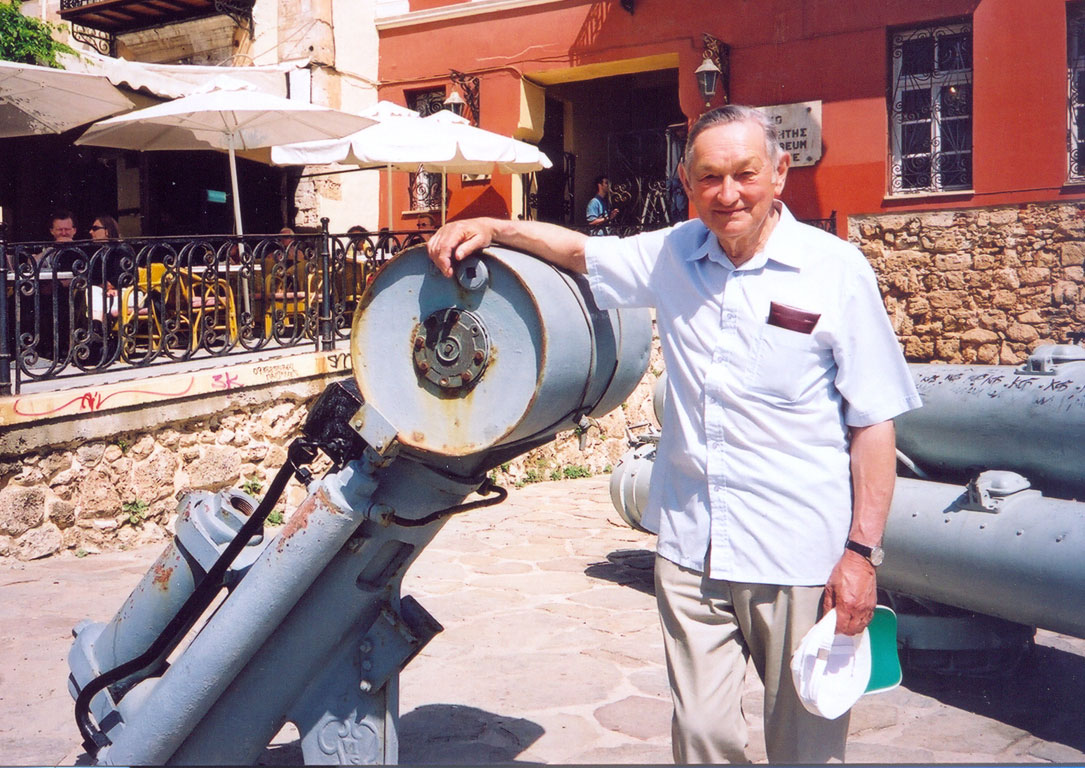
Alan
Marsh and Elaine visited the Maritime Museum in Chania, Crete, in 2002
and she photographed him leaning on a depth charge thrower (with George VI R) similar to
those on HMS Versatile
On the right is a triple antisubmarine torpedo launcher dating from the 70s - or later.
It would be impossible to overstate the significance of his time in HMS Versatile,
his first ship in which he served as both midshipman and
sub-lieutenant.
He looked back on this time with pride and great
affection all his life.
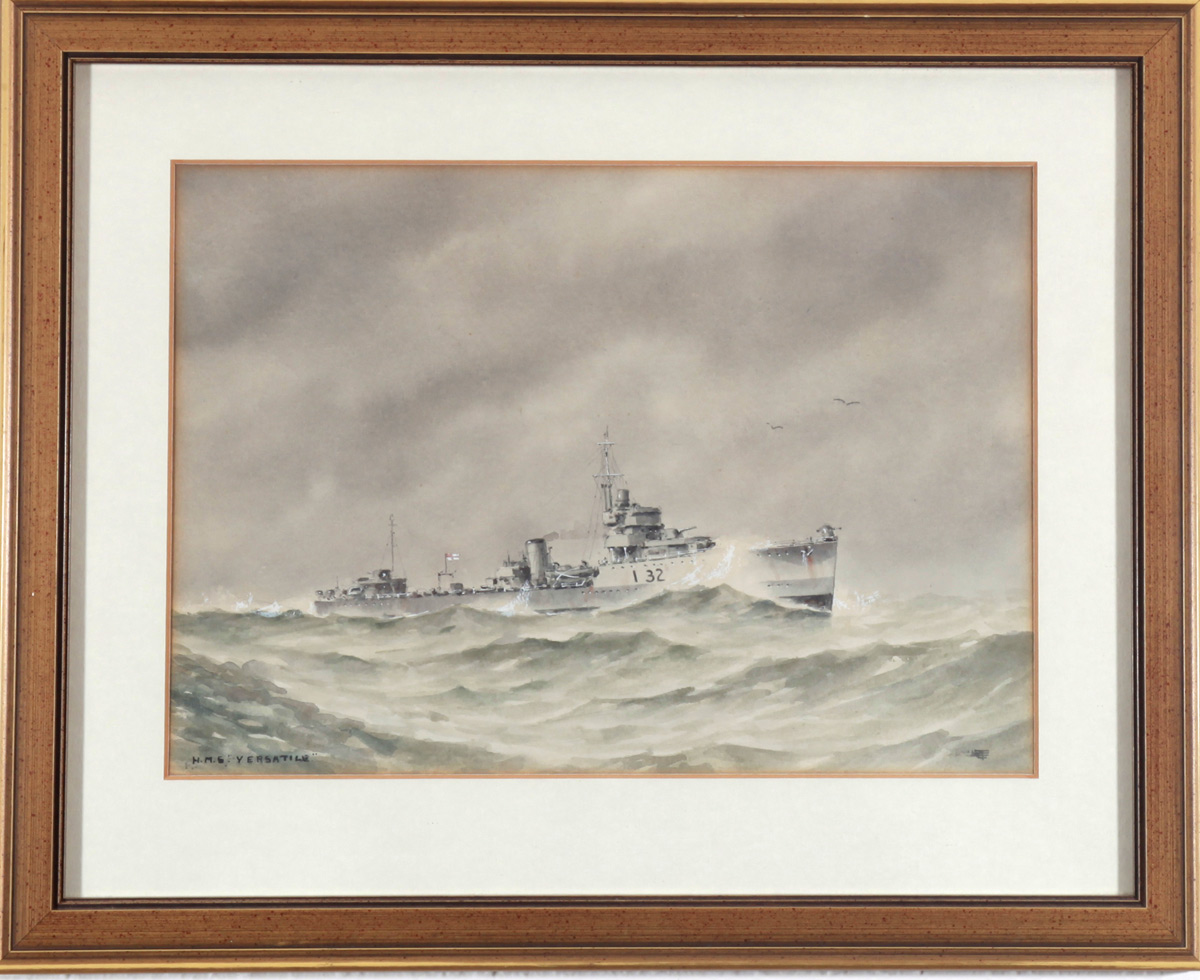

A 1:350 scale white metal model of HMS Versatile made by Skytrex Ltd and given by Elaine Marsh to her husband
Photograph courtesy of Lucilla Phelps FRPS